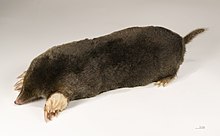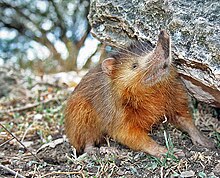| Eulipotyphla Temporal range: Paleocene–Recent PreꞒ Ꞓ O S D C P T J K Pg N | |
|---|---|

| |
| Clockwise from upper left: a solenodon, hedgehog, mole and shrew | |
| Scientific classification | |
| Domain: | Eukaryota |
| Kingdom: | Animalia |
| Phylum: | Chordata |
| Class: | Mammalia |
| Magnorder: | Boreoeutheria |
| Superorder: | Laurasiatheria |
| Order: | Eulipotyphla Waddell et al., 1999 |
| Families | |
| |
| Synonyms | |
| |
Eulipotyphla (/ˌjuːlɪpoʊˈtɪflə/, from eu- + Lipotyphla; sometimes called true insectivores) is an order of mammals comprising the Erinaceidae (hedgehogs and gymnures); Solenodontidae (solenodons); Talpidae (moles, shrew-like moles and desmans); and Soricidae (true shrews) families.
Taxonomic history
Historically, these animals were grouped with others such as treeshrews, elephant shrews, and colugos, under the broader category Insectivora, comprising all small insect-eating placental mammals. Wilhelm Peters identified two sub-groups of Insectivora, distinguished by the presence or absence of a cecum in the large intestine. In his 1866 Generelle morphologie der organismen, Ernest Haeckel named these groups Menotyphla and Lipotyphla, respectively from μένω ("remain")/λείπω ("lack" or "leave behind") + τυφλὸν literally "blind", as in τυφλὸν ἔντερον ("blind intestine", from which the Latin intestinum caecum derives as a calque).
Since the late 1990s, molecular studies have produced evidence that the Lipotyphla are not a monophyletic group. This led to tenrecs, otter shrews, and golden moles being placed a new order (Afrosoricida, in the superorder Afrotheria), with the remaining members of Lipotyphla being reclassified as Eulipotyphla.
A 2023 study suggested that the order began to diversify prior to the K-Pg extinction, based on molecular clock estimates.
Classification
Further information: List of eulipotyphlans



- Order Eulipotyphla (= 'Lipotyphla' - Afrosoricida = 'Erinaceomorpha' + 'Soricomorpha')
- Family Erinaceidae
- Subfamily Erinaceinae: hedgehogs
- Subfamily Galericinae: gymnures or moonrats
- Family Soricidae
- Subfamily Crocidurinae: white-toothed shrews
- Subfamily Soricinae: red-toothed shrews
- Subfamily Myosoricinae: African white-toothed shrews
- Family Talpidae
- Subfamily Talpinae: Old World moles and desmans
- Subfamily Scalopinae: New World moles
- Subfamily Uropsilinae: shrew-like moles
- Family Solenodontidae: solenodons
- † Family Nesophontidae: extinct West Indian shrews
- † Family Amphilemuridae
- † Family Nyctitheriidae
- † Family Plesiosoricidae
- Family Erinaceidae
Family-level cladogram of modern eulipotyphlan relationships, following Roca et al. and Brace et al.:
| Eulipotyphla |
| ||||||||||||||||||||||||
The upper and lower basal subclades within the tree are the suborders Solenodonota and Erinaceota, respectively. These two branches are estimated to have split ~72–74 million years (Ma) ago. The Nesophontidae and Solenodontidae are thought to have separated roughly 57 Ma ago. Split times for talpids vs. soricids plus erinaceids, and for soricids vs. erinaceids, have been estimated at 69 Ma and 64 Ma ago, respectively.
Notes
- Either a European hedgehog or a northern white-breasted hedgehog
References
- Buckley, Michael; Harvey, Virginia L; Orihuela, Johanset; Mychajliw, Alexis M; Keating, Joseph N; Milan, Juan N Almonte; Lawless, Craig; Chamberlain, Andrew T; Egerton, Victoria M; Manning, Phillip L (2020-06-04). "Collagen Sequence Analysis Reveals Evolutionary History of Extinct West Indies Nesophontes (Island-Shrews)". Molecular Biology and Evolution. 37 (10): 2931–2943. doi:10.1093/molbev/msaa137. ISSN 0737-4038. PMC 7530613.
- ^ Douady, C. J.; Chatelier, P. I.; Madsen, O.; de Jong, W. W.; Catzeflis, F.; Springer, M. S.; Stanhope, M. J. (October 2002). "Molecular phylogenetic evidence confirming the Eulipotyphla concept and in support of hedgehogs as the sister group to shrews". Molecular Phylogenetics and Evolution. 25 (1): 200–209. doi:10.1016/S1055-7903(02)00232-4. PMID 12383761.
- Ohl, Michael (2018). The art of naming. Translated by Lauffer, Elisabeth. Cambridge, Massachusetts London: The MIT Press. pp. 7–9. ISBN 978-0-262-03776-1.
- "caecum | Etymology of caecum by etymonline". www.etymonline.com. Retrieved 2024-10-23.
- ^ Roca, A. L.; Bar-Gal, G. K.; Eizirik, E.; Helgen, K. M.; Maria, R.; Springer, M. S.; O'Brien, S. J.; Murphy, W. J. (2004-06-10). "Mesozoic origin for West Indian insectivores". Nature. 429 (6992): 649–651. Bibcode:2004Natur.429..649R. doi:10.1038/nature02597. PMID 15190349. S2CID 915633.
- Bininda-Emonds, O. R. P.; Cardillo, M.; Jones, K. E.; MacPhee, R. D. E.; Beck, R. M. D.; Grenyer, R.; Price, S. A.; Vos, R. A.; Gittleman, J. L.; Purvis, A. (2007-03-29). "The delayed rise of present-day mammals". Nature. 446 (7135): 507–512. Bibcode:2007Natur.446..507B. doi:10.1038/nature05634. PMID 17392779. S2CID 4314965.
- Foley, Nicole M.; Mason, Victor C.; Harris, Andrew J.; Bredemeyer, Kevin R.; Damas, Joana; Lewin, Harris A.; Eizirik, Eduardo; Gatesy, John; Karlsson, Elinor K.; Lindblad-Toh, Kerstin; Zoonomia Consortium‡; Springer, Mark S.; Murphy, William J.; Andrews, Gregory; Armstrong, Joel C. (2023-04-28). "A genomic timescale for placental mammal evolution". Science. 380 (6643): eabl8189. doi:10.1126/science.abl8189. ISSN 0036-8075. PMC 10233747. PMID 37104581.
- ^ de Lazaro, Enrico (19 March 2018). "Solenodon Genome Sequenced". Sci-News.com. Retrieved 2019-06-23.
- ^ Grigorev, K.; Kliver, S.; Dobrynin, P.; Komissarov, A.; Wolfsberger, W.; Krasheninnikova, K.; Afanador-Hernández, Y. M.; Brandt, A. L.; Paulino, L. A.; Carreras, R.; Rodríguez, L. E.; Núñez, A.; Brandt, J. R.; Silva, F.; Hernández-Martich, J. D.; Majeske, A. J.; Antunes, A.; Roca, A. L.; O'Brien, S. J.; Martínez-Cruzado, J. C.; Oleksyk, T. K. (2018). "Innovative assembly strategy contributes to understanding the evolution and conservation genetics of the endangered Solenodon paradoxus from the island of Hispaniola". GigaScience. 7 (6): giy025. doi:10.1093/gigascience/giy025. PMC 6009670. PMID 29718205.
- Kim, N.H.; Lim, S.J.; Chae, H.M.; Park, Y.C. (2017). "Complete mitochondrial genome of the Amur hedgehog Erinaceus amurensis (Erinaceidae) and higher phylogeny of the family Erinaceidae". Genetics and Molecular Research. 16 (1). doi:10.4238/gmr16019300. PMID 28198504.
- Dubey, S.; Salamin, N.; Ohdachi, S.D.; Barrière, P.; Vogel, P. (2007). "Molecular phylogenetics of shrews (Mammalia: Soricidae) reveal timing of transcontinental colonizations". Molecular Phylogenetics and Evolution. 44 (1): 126–137. doi:10.1016/j.ympev.2006.12.002. PMID 17267241. S2CID 3136125.
- He, K.; Shinohara, A.; Helgen, K.M.; Springer, M.S.; Jiang, X.-L.; Campbell, K.L. (2017). "Talpid Mole Phylogeny Unites Shrew Moles and Illuminates Overlooked Cryptic Species Diversity". Molecular Biology and Evolution. 34 (1): 78–87. doi:10.1093/molbev/msw221. PMID 27795230.
- ^ Brace, S.; Thomas, J. A.; Dalén, L.; Burger, J.; MacPhee, R. D. E.; Barnes, I.; Turvey, S. T. (2016). "Evolutionary History of the Nesophontidae, the Last Unplaced Recent Mammal Family". Molecular Biology and Evolution. 33 (12): 3095–3103. doi:10.1093/molbev/msw186. PMID 27624716.
- Springer, M. S.; Murphy, W. J.; Roca, A. L. (2018). "Appropriate fossil calibrations and tree constraints uphold the Mesozoic divergence of solenodons from other extant mammals". Molecular Phylogenetics and Evolution. 121: 158–165. doi:10.1016/j.ympev.2018.01.007. PMID 29331683.
| Taxon identifiers | |
|---|---|
| Eulipotyphla | |